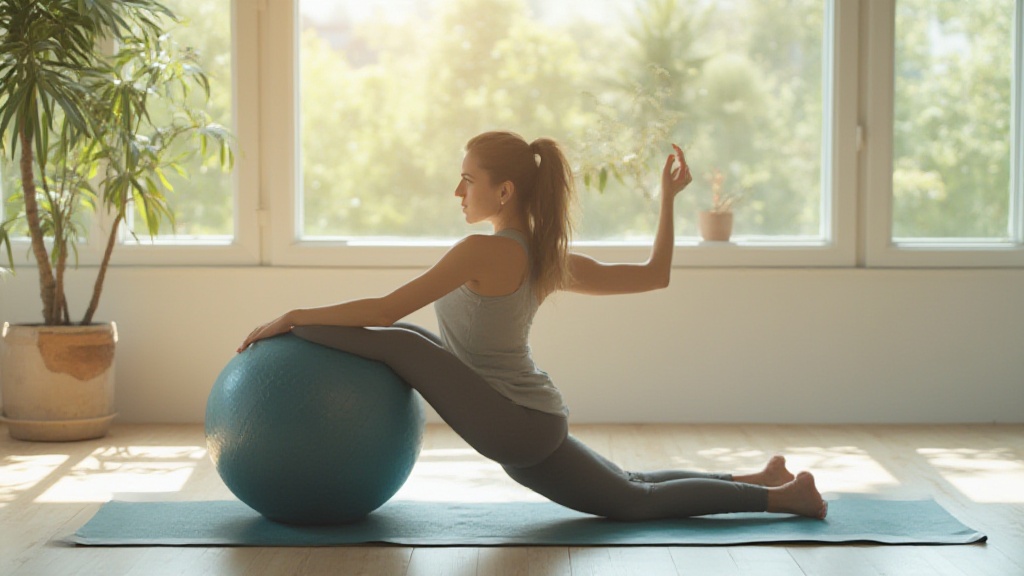
Core stability exercises play an important role in overall fitness and health. These exercises focus on strengthening the muscles in your abdomen, lower back, and hips, which significantly contribute to overall strength and performance.
By engaging in core stability training, individuals not only enhance their physical performance but also improve balance and coordination, leading to better functional fitness.
Strong core muscles support daily activities and reduce the risk of injuries, particularly in the lower back.
The Importance of Core Strength for Stability
Core strength directly influences optimal body stability during movement.
Developing your core enhances muscle control and overall body awareness, both of which play a key role in everyday activities. Proper posture is directly influenced by a strong core, impacting everything from walking to sitting.
Weak core muscles can lead to poor posture, resulting in discomfort and potential long-term health consequences.
Daily Routine for Enhanced Core Stability
To effectively promote core stability, consider incorporating the following exercises into your daily routine:.
- Planks: These exercises engage the entire core and improve core endurance.
- Bridges: This exercise strengthens the glutes and lower back, enhancing lower back support.
- Pelvic Tilts: This movement helps with core activation and trunk stability.
Consistency in these core conditioning drills will greatly benefit your fitness goals and overall well-being. Tailoring your workouts with these exercise variations can improve functional fitness and reduce the risk of injury.
As you progress, consider integrating other forms of training such as yoga for core strength or Pilates to further enhance your core conditioning routine. These disciplines focus on dynamic stability and movement efficiency, which are essential for athletic performance and rehabilitation exercises.
Incorporating a range of fitness routines that include balance workouts and flexibility workouts will contribute to greater overall strength and resilience.

Effective Abdominal Workouts For All
Enhancing core strength through effective abdominal workouts supports individuals at any fitness level. Beginner-friendly exercises like planks and dead bugs provide a solid foundation, while Russian twists and bicycle crunches cater to intermediate athletes.
For advanced practitioners, hanging leg raises and the ab wheel rollout present intense challenges.
Tailoring these workouts to your fitness level ensures not only safety but also engagement.
To seamlessly integrate these workouts into a weekly schedule, aim for 2-3 core sessions, allowing ample time for rest and recovery. Consistency leads to steady progress in core conditioning.
How Stability Training Enhances Performance
Enhancing athletic performance significantly relies on the incorporation of stability training.
Engaging in exercises that improve balance and muscle control can lead to better coordination during sports. Stability training plays an essential role in injury prevention, particularly in activities that demand quick movements and agility.
Including exercises such as
- single-leg balance
- stability ball exercises
within your routine can maximize performance outcomes while minimizing injury risks. Structuring your training to incorporate stability work on dedicated training days or during warm-ups contributes to enhanced athletic conditioning and overall movement efficiency.
Core Strength and Stability Training
- Core strength is essential for overall stability and balance, aiding in daily activities and athletic performance.
- Research indicates that stability training can reduce the risk of injuries by improving proprioception and muscle coordination.
- Incorporating core workouts 2-3 times a week can lead to significant improvements in strength and endurance.
- Exercises like single-leg balance and stability ball workouts engage multiple muscle groups, enhancing overall athletic performance.
Benefits Of Balance Workouts For Core
Balance workouts provide substantial benefits, particularly in the development of core strength. Engaging regularly in these exercises significantly enhances overall stability, which is essential for various daily tasks and activities.
Strong core stability is fundamental for effective coordination, which plays a key role in improving movement efficiency.
Common exercises, such as single-leg stands and stability ball routines, can easily be integrated into home workouts, delivering impactful results.
- Single-leg stands: Stand on one leg, with the opposite knee bent, which challenges balance and engages the core.
- Stability ball routines: Perform abdominal workouts while balancing on a stability ball, promoting muscle control and activation.
Incorporating these practical exercises into your fitness routine can significantly enhance your overall core conditioning and functional movement.
Exploring Functional Fitness With Core Exercises
Functional fitness principles are increasingly linked to core workouts that enhance core endurance. These exercises mimic everyday movements, thereby improving physical performance in daily activities. For example, exercises such as planks and rotational movements effectively enhance core engagement while supporting trunk stability.
- Planks: This exercise aids in building trunk stability and overall strength endurance.
- Bridges: Strengthens lower back support while improving flexibility and core activation.
Measuring progress in core workouts is essential; tracking improvements in strength and endurance provides valuable insights into your growth in functional fitness.
Core Workouts
- Studies show that balance training can improve overall stability by up to 30%, enhancing performance in daily activities.
- Research indicates that incorporating core exercises like planks can increase core endurance by 20% over a 6-week training period.
- Engaging in stability ball routines can activate up to 90% of core muscles, leading to better muscle control and strength.
- Functional fitness exercises have been found to reduce the risk of injury by improving coordination and balance in everyday movements.
The Role Of Pilates In Core Conditioning
Core conditioning serves as a foundational aspect of overall fitness, enhancing strength, balance, and stability. Pilates distinguishes itself as a unique modality, emphasizing core strength through controlled, mindful movement.
By engaging the core consistently, practitioners notice improved body awareness, which proves essential for effective exercise routines.
Compared to traditional strength training, Pilates adopts a distinctive approach, prioritizing core engagement rather than simply relying on brute strength.
Beginners might find success with simple routines such as the Hundred for warm-up and Plank exercises to enhance stability. These foundational movements not only improve strength but also support flexibility, contributing to lower back support and overall functional fitness.
Yoga For Core Strength: Key Poses
Yoga emphasizes core strength as an integral component of comprehensive fitness strategies.
Core strength significantly enhances balance and stability, essential for effective execution of diverse poses. Engaging in key poses, such as Boat Pose (Navasana) and Plank Pose (Phalakasana), directly targets the core, fostering improved endurance and muscle control.
Practicing these poses nurtures mental clarity, linking physical balance with mindful movement.
To effectively incorporate these exercises into daily routines, consider establishing a consistent schedule and integrating them into overall functional movement practices.
By doing so, individuals can achieve substantial advancements in core stability, enriching their fitness journey.
Core Conditioning
- Pilates focuses on controlled movements that enhance core strength and stability.
- Practicing core-focused exercises like the Hundred and Plank can improve overall body awareness.
- Yoga poses such as Boat Pose and Plank Pose enhance core strength, balance, and mental clarity.
- Consistent practice of core conditioning exercises contributes to better functional fitness and lower back support.
Why Core Engagement Matters For Health
Core engagement is fundamental for achieving optimal health outcomes. Core strength plays a pivotal role in overall stability, enhancing athletic performance and enabling individuals to execute tasks with improved efficiency.
Engaging the core effectively can significantly reduce the risk of injuries, particularly in the lower back.
Practicing balance workouts and incorporating core stability exercises into your daily fitness routine can be beneficial.
For instance, Pilates and planking techniques not only improve muscle control but also enhance flexibility and resilience.
By prioritizing core activation, individuals can foster better posture and support injury prevention while improving overall functional fitness. Core conditioning contributes to enhanced movement efficiency, allowing for more effective performance in various activities.
Engaging in strength training exercises specifically targeting the transverse abdominis and oblique muscles can further bolster core endurance and stability.
The Importance of Core Engagement in Injury Prevention and Rehabilitation
Core engagement is crucial for injury prevention, particularly regarding lower back support and rehabilitation. Employing dynamic stability exercises helps strengthen the muscles around the trunk, reducing the likelihood of injuries during physical activities.
Fitness routines that emphasize core engagement contribute to improved proprioception and body awareness, which are essential for preventing falls and accidents.
Incorporating rehabilitation exercises focused on core activation allows individuals recovering from injuries to regain strength and mobility safely.
Utilizing stability balls or balance boards can further enhance core challenges, making workouts more effective.
Maintaining proper posture through core engagement is critical for long-term health, as it can alleviate strain on the back and promote better overall alignment.
To improve core engagement in daily life, consider integrating isometric exercises into your routine. These exercises enhance muscle control and stability while being adaptable to any fitness level.
Engage in flexibility workouts that harmonize with core training for a comprehensive approach to health and wellness, ultimately leading to improved overall performance.
Core Engagement
- Core strength is essential for overall stability and athletic performance.
- Effective core engagement can significantly reduce the risk of lower back injuries.
- Dynamic stability exercises enhance proprioception and body awareness, crucial for preventing falls.
- Isometric exercises can be adapted to any fitness level, improving muscle control and stability.
